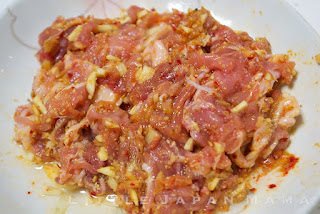
One of our favorite foods is Piiman no Nikuzume - Japanese stuffed peppers. They're surprisingly quick and easy, and I make them quite often, the only reason why I haven't done a post yet is because in Australia we didn't have real piiman, so I was making them with green capsicums (bell peppers)! Luckily they taste great made with capsicums/bell peppers so anyone around the world can make them.
This version of Piiman no Nikuzume is our favorite, with a thick, juicy, glaze-like sauce.
(It took me a while to think of those adjectives... in Japanese I would simply describe it as: toro~ri!)
Based on this recipe by ラビー on cookpad.
Piiman no Nikuzume
4-9 small green bell peppers/capsicums(what you really want is piiman but I think they're only in Japan)
300g pork mince
a large handful of chopped shallots (green onions) OR 1 small onion, chopped very finely
1/4 cup panko (breadcrumbs)
1 egg
Sauce Ingredients (mixed together in a cup):
2 Tbsp soy sauce
2 Tbsp mirin
1 Tbsp sugar
1 tsp dashi powder OR chicken stock powder (Since it's yoshoku, why not?)
2 Tbsp cornstarch, mixed with a little water
- Place egg, panko and mince in a mixing bowl, and knead/mix until well combined. Mix in shallots.
- Slice peppers/capsicums in half or, if you couldn't get small ones, (as I often found in Australia) slice in thirds or quarters lengthwise along the natural lines of the capsicum, making sure they have enough depth and roundness to hold the filling in. You can sprinkle the insides with flour if you like, to help them to stick better, but I find this is not usually necessary.
- Heat a little oil in a frypan, and arrange the peppers, skin side down, until the surface just has a grill mark.
- Flip the peppers so the pork side is down, press gently. Cook until well browned.
- Flip peppers pork side up again and use a paper towel to wipe excess oil from the frypan. Add Sauce Ingredients to the frypan and simmer until pork is cooked through.
- Place peppers on serving plates. Add cornstarch mixture to the frypan, stir and bring to boil to thicken. Pour over peppers. Serve immediately, with rice and salad if you like.
Sprinkle with Shichimi if you like a little spice.







.jpg)













.jpg)


















